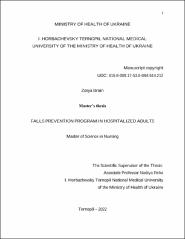| dc.description.abstract | Falls among hospitalized patients are one of the most severe sentinel events and take a lot of hospital staff's attention. Many efforts have been made to prevent falls among hospitalized patients, and much research was dedicated to the topic. Hospital falls could lead to severe complications in patients' care. According to National Database for Nursing Quality Indicators (NDNQI), all falls can be categorized into five injury levels: none, minor, moderate, major, and death. If inpatient falls result in injuries, hospitals can suffer from financial losses due to additional tests and rehabilitation needs.
Moreover, patients and families can suffer from emotional trauma due to falls and complications. Therefore, as a future prepared nurse executive, I see fall prevention as a significant part of my professional duty. Maintaining patient safety is one of the most critical nursing roles. Fall prevention feeds in this category. Therefore, this topic is very vital for my professional development as a nurse and future nursing executive. Professional literature also points out the importance of fall prevention, highlighting that according to The World Health Organization (WHO), 37.3 million hospital falls annually require medical intervention. More than half a million deaths were recorded due to hospital falls. Nursing research has been identified many risk factors for potential falls among hospitalized adults. The most common characteristics are patients with cognitive impairment and altered mental status. Additional factors related to falls among hospitalized adults reported as pharmaceutical medications affecting alertness and increased fall risk, lack of communication between patients and medical staff, and insufficient education regarding falls within hospital populations. Another fall risk population is patients suffering from mental illnesses, drug or alcohol withdrawal due to possible delirium or disorientation. Also, patients diagnosed with vasovagal syncope episodes or incontinence could be at high risk for falling. | uk |

